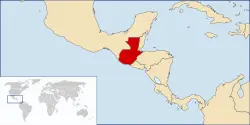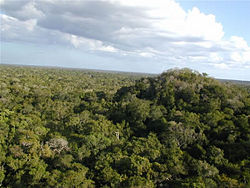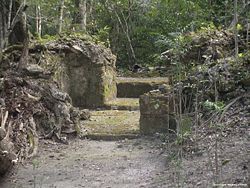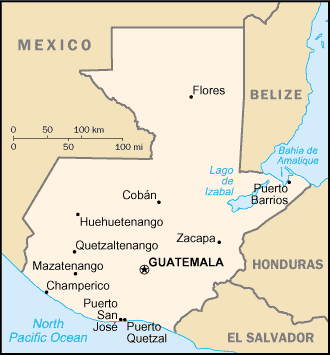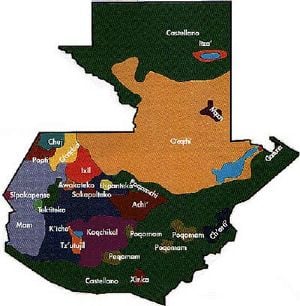Guatemala
- This article is about the country in Central America. For other uses, see Guatemala (disambiguation)
| República de Guatemala Republic of Guatemala | |||||
| |||||
| Motto: El País de la Eterna Primavera [citation needed] "Land of Eternal Spring" | |||||
| Anthem: Himno Nacional de Guatemala | |||||
| Capital | Guatemala City 14°38′N 90°30′W | ||||
|---|---|---|---|---|---|
| Largest city | capital | ||||
| Official languages | Spanish | ||||
| Government | Presidential republic | ||||
| - President | Oscar Berger | ||||
| Independence | from Spain | ||||
| - Date | September 15, 1821 | ||||
| Area | |||||
| - Total | 108,890 km² (106th) 42,042 sq mi | ||||
| - Water (%) | 0.4 | ||||
| Population | |||||
| - July 2005 estimate | 12,800,000 | ||||
| - Density | 134.6/km² 348.6/sq mi | ||||
| GDP (PPP) | 2005 estimate | ||||
| - Total | $62.78 billion | ||||
| - Per capita | $4,155 | ||||
| HDI (2004) | 0.673 (medium) | ||||
| Currency | Quetzal (GTQ)
| ||||
| Internet TLD | .gt | ||||
| Calling code | +502 | ||||
The Republic of Guatemala (Spanish: República de Guatemala, IPA: [re'puβlika ðe ɣwate'mala]), is a country in Central America bordered by Mexico to the northwest, the Pacific Ocean to the southwest, Belize and the Caribbean Sea to the northeast, and Honduras and El Salvador to the southeast.
The most populous nation in Central America, Guatemala is a representative democracy with its capital at Guatemala City. Although the nation has been relatively stable since 1996, Guatemala's recent history has been plagued by civil war and military coups, which have slowed the nation's development. Large portions of Guatemala's interior remain wholly undeveloped, including the nation's many rainforests and wetlands. Guatemala's abundance of biologically significant and unique ecosystems contribute to Mesoamerica's designation as an important biodiversity hotspot.[1]
Etymology
The country name comes from the Nahuatl Cuauhtēmallān, "place of many trees", a translation of K'iche' Mayan K’ii’chee’, "many trees" (that is, "forest").[2]
History
Pre-Columbian
The first proof of human settlers in Guatemala goes back to 10,000 B.C.E., although there is some evidence that puts this date at 18,000 B.C.E., such as obsidian arrow heads found in various parts of the country.[3] There is archaeological proof that early Guatemalan settlers were hunters and gatherers, but pollen samples from Petén and the Pacific coast indicate that maize cultivation was developed by 3500 B.C.E.[4] Archaic sites have been documented in Quiché in the Highlands and Sipacate, Escuintla on the central Pacific coast (6500 B.C.E.).
Archaeologists divide the pre-Columbian history of Mesoamerica into 3 periods: The Pre-Classic from 2000 B.C.E. to 250 C.E., the Classic from 250 to 900 C.E., and the Post-Classic from 900 to 1500 C.E.[5] Until recently, the Pre-Classic was regarded as a formative period, with small villages of farmers who lived in huts, and few permanent buildings, but this notion has been challenged by recent discoveries of monumental architecture from that period, such as an altar in La Blanca, San Marcos, some 3 mt. in diameter from 1000 B.C.E.; ceremonial sites at Miraflores and El Naranjo from 800 B.C.E.; the earliest monumental masks; and the Mirador Basin cities of Nakbé, Xulnal, Tintal, Wakná and El Mirador.
El Mirador was by far the most populated city in the pre-Columbian America, and contained the largest pyramid in the world, at 2,800,000 cubic meters in volume (some 200,000 more than the Great Pyramid of Giza in Egypt). Mirador was the first politically organized state in America, named the Kan Kingdom in ancient texts. There were 26 cities, all connected by Sacbeob (highways), which were several kilometers long, up to 40 meters wide, and 2 to 4 meters above the ground, paved with stucco, that are clearly distinguishable from the air in the most extensive virgin tropical rain forest in Mesoamerica.
The Classic period of Mesoamerican civilization corresponds to the height of the Maya civilization, and is represented by countless sites throughout Guatemala, although the largest concentration is in Petén. This period is characterized by heavy city-building, the development of independent city-states, and contact with other Mesoamerican cultures.
This lasted until around 900 C.E., when, for reasons not understood by archaeologists, the Maya went into decline, and abandoned many of the cities of the central lowlands. The Post-Classic period is represented by regional kingdoms such as the Itzá and Ko'woj in the Lakes area in Petén, and the Mam, Ki'ch'es, Kack'chiquel, Tz'utuh'il, Pokom'chí, Kek'chi and Chortí in the Highlands. These cities preserved many aspects of Mayan culture, but would never equal the size or power of the Classic cities.
Colonial
After discovering the New World, the Spanish mounted several peaceful expeditions to Guatemala, beginning in 1518. Before long, Spanish contact resulted in an epidemic that devastated native populations (believed to be Viruela, Spanish smallpox, based on the description in the "Memorial de Sololá"). [citation needed]
Hernándo Cortés, who had led the Spanish conquest of Mexico, granted a permit to Captain Pedro de Alvarado, to conquer this land. Alvarado at first allied himself with the Cakchiquel nation to fight against their traditional rivals the Quiché nation. Alvarado later turned against the Cakchiquels, and eventually held the entire region under Spanish domination.
During the colonial period, Guatemala was a Captaincy General (Capitanía General de Guatemala) of Spain, and a part of New Spain (Mexico). It extended from the Soconusco region - now in southern Mexico (states of Chiapas, Tabasco) - to Costa Rica. This region was not as rich in minerals (gold and silver) as Mexico and Peru, and was therefore not considered to be as important. Its main products were sugarcane, cocoa, blue añil dye, red dye from cochineal insects, and precious woods used in artwork for churches and palaces in Spain.
The first Capital was named Tecpan Guatemala, founded in July 25 1524 with the name of (Villa de Santiago de Guatemala) and was located near Iximché, the Cakchiquel's capital city, It was moved to Ciudad Vieja on November 22 1527, when the Cakchiquel attacked the city. On September 11 1541 the city was flooded when the lagoon in the crater of the Agua Volcano collapsed due to heavy rains and earthquakes, and was moved 4 miles to Antigua Guatemala, on the Panchoy Valley, now a UNESCO World Heritage Site. This City was destroyed by several earthquakes in 1773-1774, and the King of Spain, granted the authorization to move the Captaincy General, to the Ermita Valley, named after a Catholic Church to the Virgen de El Carmen, in its current location, founded in January 2 1776.
Independence
On September 15, 1821, Guatemala declared itself independent from Spain.
On October 3 1821, the Captaincy-General of Guatemala, (formed by Chiapas, Guatemala, El Salvador, Nicaragua, Costa Rica and Honduras) officially proclaimed its independence from Spain and its incorporation into the Mexican Empire. This region had been formally subject to New Spain throughout the colonial period, but as a practical matter was administered separately. All but Chiapas soon separated from Mexico after Agustín I from Mexico was forced to abdicate.
The Guatemalan provinces formed the United Provinces of Central America, also called the Central American Federation (Federacion de Estados Centroamericanos).
- Territorial Dispute
Guatemala has long claimed all or part of the territory of neighbouring Belize, formerly part of the Spanish colony, and currently an independent Commonwealth Realm which recognises Queen Elizabeth II as its Head of State. Guatemala recognized Belize's independence in 1990, but their territorial dispute is not resolved. Negotiations are currently underway under the auspices of the Organization of American States and the Commonwealth of Nations to conclude it.[6][7]
The Modern Fight for a Nation
On July 4, 1944, Dictator Jorge Ubico Castañeda was forced to resign his office in response to a wave of protests and a general strike. His replacement, General Juan Federico Ponce Vaides, was forced out of office on October 20, 1944 by a coup d'état led by Major Francisco Javier Arana and Captain Jacobo Arbenz Guzmán. About 100 people were killed in the coup. The country was led by a military junta made up of Arana, Arbenz, and Jorge Toriello Garrido. The Junta called Guatemala's first free election, which was won with a majority of 85 percent by the prominent writer and teacher Juan José Arévalo Bermejo, who had lived in exile in Argentina for 14 years. Arévalo was the first democratically elected president of Guatemala to fully complete the term for which he was elected. His "Christian Socialist" policies, inspired by the U.S. New Deal, were criticized by landowners and the upper class as "communist."
This period was also the beginning of the Cold War between the U.S. and the USSR, which was to have a considerable influence on Guatemalan history. From the 1950s through the 1990s, the U.S. government directly supported Guatemala's army with training, weapons, and money.
In 1954, Arévalo's freely elected Guatemalan successor, Jacobo Arbenz, was overthrown by the U.S. Central Intelligence Agency (CIA) and a small group of Guatemalans (landowners, the old military caste, and the Catholic Church), after the government instituted decree No. 900, which expropriated large tracts of land owned by the United Fruit Company, a U.S.-based banana merchant (Chiquita Banana). The CIA codename for the coup was Operation PBSUCCESS (it was the CIA's second successful overthrow of a foreign government after the 1953 coup in Iran). Colonel Carlos Castillo Armas was installed as president in 1954 and ruled until he was assassinated by a member of his personal guard in 1957.
In the election that followed, General Miguel Ydígoras Fuentes assumed power. He is most celebrated for challenging the Mexican president to a gentleman’s duel on the bridge on the south border to end a feud on the subject of illegal fishing by Mexican boats on Guatemala's Pacific coast, two of which were sunk by the Guatemalan Air Force. Ydigoras authorized the training of 5,000 anti-Castro Cubans in Guatemala. He also provided airstrips in the region of Petén for what later became the failed Bay of Pigs Invasion in 1961. Ydigoras' government was ousted in 1963 when the Air Force attacked several military bases. The coup was led by his Defense Minister, Colonel Enrique Peralta Azurdia.
In 1966, Julio César Méndez Montenegro was elected president of Guatemala under the banner "Democratic Opening." Mendez Montenegro was the candidate of the Revolutionary Party, a center-left party which had its origins in the post-Ubico era. It was during this time that rightist paramilitary organizations, such as the "White Hand" (Mano Blanca), and the Anticommunist Secret Army, (Ejército Secreto Anticomunista), were formed. Those organizations were the forerunners of the infamous "Death Squads." Military advisers of The United States Army Special Forces (Green Berets) were sent to Guatemala to train troops and help transform its army into a modern counter-insurgency force, which eventually made it the most sophisticated in Central America.
In 1970, Colonel Carlos Manuel Arana Osorio was elected president. A new guerrilla movement entered the country from Mexico, into the Western Highlands in 1972. In the disputed election of 1974, General Kjell Lauguerud García defeated General Efraín Ríos Montt, a candidate of the Christian Democratic Party, who claimed that he had been cheated out of a victory through fraud. On February 4, 1976, a major earthquake destroyed several cities and caused more than 25,000 deaths. In 1978, in a fraudulent election, General Romeo Lucas García assumed power. The 1970s saw the birth of two new guerrilla organizations, The Poor Guerrilla Army (EGP) and the Organization of the Peoples in Arms (ORPA), who began and intensified by the end of the seventies, guerrilla attacks that included urban and rural guerrilla warfare, mainly against the military and some of the civilian supporters of the army. In 1979, the United States president, Jimmy Carter, ordered a ban on all military aid to the Guatemalan Army because of the widespread and systematic abuse of human rights. Almost immediately, the Israeli Government took over supplying the Guatemalan Army with advisors, weapons and other military supplies.
In 1980, a group of Quiché Indians took over the Spanish Embassy to protest army massacres in the countryside. The Guatemalan government launched an assault that killed almost everyone inside as a result of a fire that consumed the building. The Guatemalan government claimed that the activists set the fire and immolated themselves. However, the Spanish ambassador, who survived the fire, disputed this claim, noting that the Guatemalan police intentionally killed almost everyone inside and set the fire to erase traces of their acts. As a result of this incident, the government of Spain broke diplomatic relations with Guatemala. This government was overthrown in 1982. General Efraín Ríos Montt was named President of the military junta, continuing the bloody campaign of torture, disappearances, and "scorched earth" warfare. The country became a pariah state internationally. Ríos Montt was overthrown by General Óscar Humberto Mejía Victores, who called for an election of a national constitutional assembly to write a new constitution, leading to a free election in 1986, which was won by Vinicio Cerezo Arévalo, the candidate of the Christian Democracy Party.
In 1982, the four Guerrilla groups, EGP, ORPA, FAR and PGT, merged and formed the URNG, influenced by the Salvadoran guerrilla FMLN, the Nicaraguan FSLN and Cuba's Government, in order to become stronger. As a result of the Army's "scorched earth" tactics in the countryside, more than 45,000 Guatemalans fled across the border to Mexico. The Mexican government placed the refugees in camps in Chiapas and Tabasco.
In 1992, the Nobel Peace Prize was awarded to Rigoberta Menchú for her efforts to bring international attention to the government-sponsored genocide against the indigenous population.
The bloody 35-year old war of repression ended in 1996 with a peace accord between the guerrillas and the government of President Álvaro Arzú, negotiated by the United Nations through intense brokerage by nations such as Norway and Spain. Both sides made major concessions. The guerrilla fighters disarmed and received land to work. According to the U.N.-sponsored truth commission (styled the "Commission for Historical Clarification"), government forces and state-sponsored paramilitaries were responsible for over 93% of the human rights violations during the war.[8] During the first 10 years, the victims of the state-sponsored terror were primarily students, workers, professionals, and opposition figures, but in the last years they were thousands of mostly rural Mayan farmers and non-combatants. More than 450 Mayan villages were destroyed and over 1 million people became internal and external refugees. In certain areas, such as Baja Verapaz, the Truth Commission considered that the Guatemalan state engaged in an intentional policy of genocide against particular ethnic groups in the Civil War.[8] In 1999, U.S. president Bill Clinton stated that the United States was wrong to have provided support to Guatemalan military forces that took part in the brutal civilian killings.[9]
Since the peace accords, Guatemala has enjoyed successive democratic elections, most recently in 2003. The current government has signed free trade agreements with the United States and the rest of Central America through CAFTA, and other agreements with Mexico, and Panama.
Politics
Politics of Guatemala takes place in a framework of a presidential representative democratic republic, whereby the President of Guatemala is both head of state and head of government, and of a pluriform multi-party system. Executive power is exercised by the government. Legislative power is vested in both the government and the Congress of the Republic. The Judiciary is independent of the executive and the legislature.
Departments and municipalities
Guatemala is divided into 22 departments (departamentos) and sub-divided into about 332 municipalities (municipios).
The departments include:
|
|
Guatemala is heavily centralized. Transportation, communications, business, politics, and most relevant urban activity takes place in Guatemala City.
Guatemala City has about 2 million inhabitants within the city limits and more than 5 million within in the urban area. This is a significant percentage of the population (12 million).Template:Check
Geography
Guatemala is mountainous, except for the south coastal area and the northern vast lowlands of Petén department. Two mountain chains enter Guatemala from west to east, dividing the country into three major regions: the highlands, where the mountains are located; the Pacific coast, south of the mountains; and the Petén region, north of the mountains. All major cities are located in the highlands and Pacific coast regions; by comparison, Petén is sparsely populated. These three regions vary in climate, elevation, and landscape, providing dramatic contrasts between hot and humid tropical lowlands and colder and drier highland peaks. Volcán Tajumulco, at 4,220 meters, is the highest point in Central America.
The rivers are short and shallow in the Pacific vertient, larger and deeper, such as the Polochic which drains in Lake Izabal Río Dulce, (Motagua) and Sartún that forms the boundary with Belize in the Caribbean and the Gulf of Mexico vertient (Usumacinta, which forms the boundary between Chiapas, Mexico and Petén and its tributaries such as La Pasión and San Pedro.
Natural disasters
Guatemala's location on the Caribbean Sea and Pacific Ocean makes it a target for hurricanes, such as Hurricane Mitch in 1998 and Hurricane Stan in October of 2005, which killed more than 1,500 people. The damage was not wind related, but rather due to significant flooding.
Guatemala's highlands lie atop the boundary between the Caribbean and North American tectonic plates, and thus are subject to frequent earthquakes and volcanic activity. Guatemala has 37 volcanoes, four of them active: Pacaya, Santiaguito, Fuego and Tacaná. The last major earthquake was on February 4 1976, killing more than 25,000 in the Central Highlands.
On June 13, 2007 a 6.8 Magnitude earthquake hit Guatemala at 3:29pm New York Time.(1:29pm Guatemalan Time) No Reports of death or major damage. It only lasted for 30 seconds and this is the second time that an earthquake happened in a week. The last time was June 8, which was a 5.9 Magnitude earthquake.
Biodiversity
The country has 14 ecoregions ranging from Mangrove forests, to both ocean littorals with 5 different ecosystems. Guatemala has an endemic Abies guatemalensis) speciesTemplate:Check. Guatemala has 252 listed wetlands, including 5 lakes, 61 lagoons. 100 rivers, 3 swamps![]() PDF, 6 of those wetlands are of international importance or RAMSAR sites.Template:Check Tikal National Park, was the first mix UNESCO World Heritage Site, in the world. Guatemala is a country of distinct fauna. Guatemala has some 1246 known species, of these, 6.7% are endemic and 8.1% are threatened species. Guatemala is home to at least 8681 species of vascular plants, of which 13.5% are endemic. 5.4% of Guatemala is protected under IUCN categories I-V. Guatemala has the largest percentage of Protected areas in Central AmericaTemplate:Check, with a total of 91 protected areas, more than 28% of the countries territory. Template:Check.
PDF, 6 of those wetlands are of international importance or RAMSAR sites.Template:Check Tikal National Park, was the first mix UNESCO World Heritage Site, in the world. Guatemala is a country of distinct fauna. Guatemala has some 1246 known species, of these, 6.7% are endemic and 8.1% are threatened species. Guatemala is home to at least 8681 species of vascular plants, of which 13.5% are endemic. 5.4% of Guatemala is protected under IUCN categories I-V. Guatemala has the largest percentage of Protected areas in Central AmericaTemplate:Check, with a total of 91 protected areas, more than 28% of the countries territory. Template:Check.
Demographics
Mestizos, known as Ladinos in Central America, or pure Amerindian but Spanish-speaking, and people of European descent (primarily of Spanish, but also those of German, English, Italian, and Scandinavian descent) comprise 60% of the population while Amerindians comprise approximately 40%. (K'iche 9.1%, Kaqchikel 8.4%, Mam 7.9%, Q'eqchi 6.3%, other Mayan 8.6%) of the population [1]. Though most of Guatemala's population is rural, urbanization is accelerating. Guatemala City is expanding at a rapid rate, and Quetzaltenango, the second largest city, is growing as well. Rural-to-urban migration is fuelled by a combination of government neglect of the countryside, low farm gate prices, oppressive labor conditions on rural plantations, the high concentration of arable land in the hands of a few wealthy families, and the (often unrealistic) perception of higher wages in the city.
In 1900, Guatemala had a population of 885,000 [2]. Over the course of the twentieth century the population of the country grew, the fastest growth in the Western Hemisphere. The ever-increasing pattern of emigration to the United States has led to the growth of Guatemalan communities in California, Florida, Illinois, New York,Texas and elsewhere since the 1970s.Template:Check
Economy
The agricultural sector accounts for about one-fourth of GDP, two-fifths of exports, and half of the labor force. Coffee, sugar, textiles, fresh vegetables, and bananas are the country's main exports. Also economically important are remittances from Guatemalans working abroad. The rate of inflation was 5.7% in 2006.
The 1996 peace accords that ended the decades-long Civil War removed a major obstacle to foreign investment.
In March 2005, despite massive street protests, Guatemala's congress ratified the Dominican Republic - Central American Free Trade Agreement (DR-CAFTA) between several Central American nations and the United States.[10] Guatemala also has free trade agreements with Taiwan and Colombia.
Culture
Guatemala City is home to many of the nation’s libraries and museums, including the National Archives, the National Library, and the Museum of Archaeology and Ethnology, which has an extensive collection of Maya artifacts. There are private museums, such as the Ixchel, which focuses on textiles, and the Popol Vuh, which focuses on Mayan archeology. Both museums are housed inside the Universidad Francisco Marroquín campus. Almost each of the 329 municipalities in the country has a small museum.
- Literature
The Guatemala National Prize in Literature is a one-time only award that recognizes an individual writer's body of work. It has been given annually since 1988 by the Ministry of Culture and Sports.
Miguel Angel Asturias, won the Literature Nobel Prize in 1966 for the Rabinal Achí, a Maya Kek'chi' play. The play was declared a Masterpiece of the Oral and Intangible Heritage of Humanity by UNESCO.[11]
Language
Although Spanish is the official language, it is not universally spoken among the indigenous population, nor is it often spoken as a second language. Twenty-one distinct Mayan languages are spoken, especially in rural areas, as well as several non-Mayan Amerindian languages, such as the indigenous Xinca, and Garifuna, an Arawakan language spoken on the Caribbean coast. According to Decreto Número 19-2003, twenty-three languages are recognized as National Languages.[12]
The Peace Accords signed in December 1996 provide for the translation of some official documents and voting materials into several indigenous languages (see summary of main substantive accords) and mandate the provision of interpreters in legal cases for non-Spanish speakers. The accord also sanctioned bilingual education in Spanish and indigenous languages. It is common for indigenous Guatemalans to learn or speak between two to five of the nation's other languages, including Spanish. [citation needed]
Religion
Catholic Christianity was the only religion during the colonial era. However, Protestantism has increased markedly in recent decades, especially under the reign of dictator and evangelical pastor General Efraín Ríos Montt. More than one third of Guatemalans are Protestant, chiefly Evangelicals and Pentecostals.
The predominant religion is Latin Rite Catholicism. Protestantism and traditional Mayan religions are practiced by an estimated 33% and 1% of the population, respectively. It is common for traditional Mayan practices to be incorporated into Christian ceremonies and worship, a phenomenon known as syncretism. The practice of traditional Mayan religion is increasing as a result of the cultural protections established under the peace accords. The government has instituted a policy of providing altars at every Mayan ruin found in the country so that traditional ceremonies may be performed there.
There are also small communities of Jews (about 1200), Muslims (1200), and members of other faiths.
Education
The government runs a number of public elementary and secondary-level schools. These schools are free, though the cost of uniforms, books, supplies, and transportation makes them less accessible to the poorer segments of society. Many middle and upper-class children go to private schools. The country also has one public university (Universidad de San Carlos de Guatemala), and 9 private ones (see List of universities in Guatemala). Only 69.1% of the population aged 15 and over are literate, the lowest literacy rate in Central America.[13]
See also
- Communications in Guatemala
- Transport in Guatemala
- List of Guatemalans
- Quetzal (national symbol of Guatemala)
Notes
- ↑ Biodiversity Hotspots-Mesoamerica-Overview. Conservation International. Retrieved 2007-02-01.
- ↑ Campbell, Lyle (1997). American Indian Languages: The Historical Linguistics of Native America. Oxford: Oxford University Press, pg. 378 n. 10
- ↑ Mary Esquivel de Villalobos. Ancient Guatemala. Authentic Maya. Retrieved 2007-04-29.
- ↑ Barbara Leyden. Pollen Evidence for Climatic Variability and Cultural Disturbance in the Maya Lowlands (PDF). University of Florida. Retrieved 2007-04-29.
- ↑ Chronological Table of Mesoamerican Archaeology. Regents of the University of California : Division of Social Sciences. Retrieved 2007-04-29.
- ↑ Montserrat Gorina-Ysern. OAS Mediates in Belize-Guatemala Border Dispute. ASIL Insights. American Society of International Law. Retrieved 2007-04-29.
- ↑ Historia General de Guatemala. ISBN 84-88622-07-4.
- ↑ 8.0 8.1 Conclusions: Human rights violations, acts of violence and assignment of responsibility. Guatemala: Memory of Silence. Guatemalan Commission for Historical Clarification. Retrieved 2006-12-26.
- ↑ Babington, Charles. "Clinton: Support for Guatemala Was Wrong", Washington Post, March 11, 1999, pp. Page A1. Retrieved 2006-12-26.
- ↑ "Guatemala Report 2006: Summary Review" Amnesty International, 2006, retrieved January 26, 2007.
- ↑ Rabinal Achi, Danse Drama. Third Proclamation of Materpieces of the Oral and Intangible Heritage of Humanity. UNESCO (2005). Retrieved 2007-06-10.
- ↑ Ley de Idiomas Nacionales, Decreto Número 19-2003 (in Spanish) (PDF). El Conreso de la Republica de Guatemala. Retrieved 2007-06-10.
- ↑ LA Literacy Rates. UNESCO Institute for Statistics (September 2006). Retrieved 2007-01-15.
ReferencesISBN links support NWE through referral fees
- Historia General de Guatemala, 1999, several authors ISBN 84-88522-07-4.
External links
- Encyclopaedia Britannica Guatemala - Country Facts Page
- UK Foreign Office Country Profile for Guatemala
- {{{2}}} at the Open Directory Project
- Sitio para la comunidad Guatemalteca - Community page
- Guatemala photo encyclopedia
Government
- (Spanish) Congreso de la República – Congress of the Republic of Guatemala
- (Spanish) Organismo Judicial de Guatemala Judicial Branch of Guatemala
- (Spanish) Gobierno de Guatemala Guatemalan Government Page
Pre-Columbian civilizations
Culture
Human Rights
- Amnesty International Annual Report 2006 – Guatemala
- Guatemala Human Rights Commission
- Network in Solidarity with the People of Guatemala
Other
- Biodiversity, Ecology and Landscapes Galleries
- Guatemala and its changes over the past 30 years By Francisco Pérez de Antón (in Spanish)
| Geographic locale |
|
Countries of Central America
Belize · Costa Rica · El Salvador · Guatemala · Honduras · Nicaragua · Panama |
| International membership |
|
Latin Union
Andorra · Angola · Argentina · Bolivia · Brazil · Cape Verde · Chile · Colombia · Costa Rica · Côte d'Ivoire · Cuba · Dominican Republic · Ecuador · El Salvador · France · Guatemala · Guinea-Bissau · Haiti · Holy See · Honduras · Italy · Mexico · Moldova · Monaco · Mozambique · Nicaragua · Panama · Paraguay · Peru · Philippines · Portugal · Romania · San Marino · São Tomé and Príncipe · Senegal · Sovereign Military Order of Malta · Spain · Timor-Leste · Uruguay · Venezuela |
Credits
New World Encyclopedia writers and editors rewrote and completed the Wikipedia article in accordance with New World Encyclopedia standards. This article abides by terms of the Creative Commons CC-by-sa 3.0 License (CC-by-sa), which may be used and disseminated with proper attribution. Credit is due under the terms of this license that can reference both the New World Encyclopedia contributors and the selfless volunteer contributors of the Wikimedia Foundation. To cite this article click here for a list of acceptable citing formats.The history of earlier contributions by wikipedians is accessible to researchers here:
The history of this article since it was imported to New World Encyclopedia:
Note: Some restrictions may apply to use of individual images which are separately licensed.


